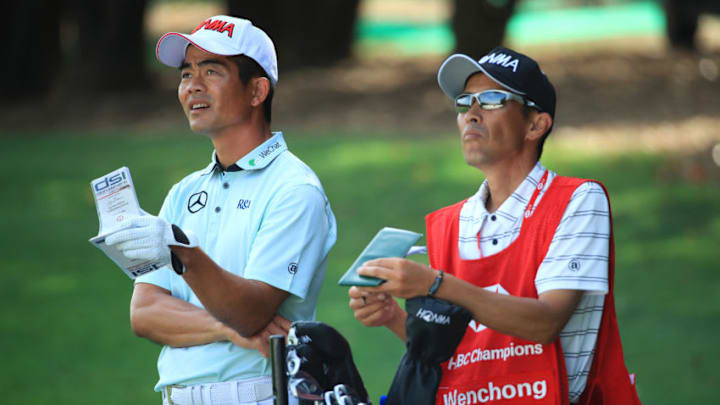The PGA TOUR enjoys some high-dollar action in star-studded fields throughout the “Asian Swing”, but top to bottom, the competition is still lacking.
With three high-dollar events played in three exotic locales, the PGA Tour just concluded its Asian Swing. It’s fast rising in status as a distinct portion – indeed the highlight – of the fall tour.
Now if it can only develop some truly competitive fields, the Asian Swing might amount to something more than a cash grab.
The three events – the CJ Cup at Nine Bridges in Korea, the brand new Zozo Championship in Japan, and the just-concluded WGC-HSBC Champions in Shanghai – certainly produced a trio of credible champions. Justin Thomas won the CJ Cup, Tiger Woods took the Zozo, and Rory McIlroy beat Xander Schauffele in a playoff to capture the WGC-HSBC while most of us slept overnight Sunday.
Together, those three winners walked away with a collective $5.255 million from a total purse of $29.25 million. To play for that much money on the PGA Tour again in three consecutively staged medal play events, you’ll have to wait for the U.S. Open, the Travelers and the WGC St. Jude next summer.
That explains the presence of players of the stripe of Thomas, Woods, McIlroy, and Schauffele on the fields.
Two reasons make it easy to understand why the PGA Tour is throwing that kind of financial muscle behind the Asian Swing. The first is the dearth of competitive opportunities. This, after all, is golf’s offseason. Weather precludes scheduling events in most of the U.S., and the two most likely domestic sites – California and Florida – both already have bulky Tour schedules after the New Year.
More from Pro Golf Now
- Golf Rumors: LIV set to sign Masters Champion in stunning deal
- Fantasy Golf: Grant Thornton Invitational DFS Player Selections
- Brutal return leaves Will Zalatoris looking towards 2024
- Stars You Know at World Champions Cup Starts Thursday at Concession
- Fantasy Golf: An Early Look at the 2024 Masters Tournament
The second reason is the developing economic potential of the Far East, which requires no elaboration.
What the Tour has not yet developed in any of those three events is the balance, the depth of field, to make those events truly competitive or memorable. As it presently stands, they are consistently the least competitive Tour-sponsored events.
Competitiveness is simple to measure by standard deviation. That’s the normal ‘spread’ of any set of numbers – say scores in a golf tournament. The lower the standard deviation of those scores, the more closely bunched – and hence the more competitive – the field.
A simple illustration will serve. Suppose there was a tournament in which 50 players entered, and they all shot 280. It doesn’t take much grasp of math to understand that the standard deviation of that field’s scores would be zero. You would, in other words, have the most highly competitive field it is possible to have.
The opposite would be a tournament in which every competitor was separated from every other by a large number: say 10 strokes. If the winner shot 280, the runner-up shot 290 and so on through all 50 competitors, the standard deviation of that field’s scores would be an astronomical 145.77. Absurd, but you get the point: the higher the standard deviation, the less competitive the field.
On the PGA Tour so far this fall, the standard deviation of the field averages for all players completing four rounds has been 5.28 strokes. That becomes our ‘norm’. But on a tournament-by-tournament basis, those standards vary widely. From most competitive to least competitive, here’s a tournament-by-tournament breakdown of the eight events to date:
Event
Safeway
Greenbrier
Houston
Sanderson Farms
Shriners
Zozo
CJ Cup
WGC-HSBC
Standard Deviation
3.98
4.06
4.34
4.45
4.97
6.33
6.67
7.46
The three Asian events form a distinct cluster at the bottom of the list. And the cluster is truly an isolated one; the gap between those three and the least competitive U.S.-based event is 1.36 strokes, far larger than the 0.99 stroke gap between the most and least competitive U.S.-based tournaments.
In theory, this gap could be a byproduct of the Asian Swing’s early placement on the tour’s calendar. There have, after all, been only eight events to assess. The evidence, however, suggests otherwise.
Among 39 individual, medal play events conducted during the 2018-19 season (excluding the FedEx Cup Playoff events), that season’s three Far East events – the CIMB in Malaysia, the CJ Cup and the WGC-HSBC – ranked 37th through 39th for competitiveness with standard deviations between 6.98 and 7.87.
For the record, the average last season was 4.91 strokes.
Why are the Far East events so much less competitive than other PGA Tour events?
The answer appears to lie in the process of selecting fields for these events. Among the 77 players at the WGC-HSBC, only 36 – that’s fewer than half – ranked among the top 265 in last season’s FedEx Cup standings. Rather, the field was populated with golfers who brought some measure of local recognition.
That included seven players from China, only one of whom, Haotong Li, you may have heard of. The average score of those seven competitors was 290.86. For the record, Mcilroy’s winning score was 269, nearly 22 strokes better.
From a promotional standpoint, it makes perfect sense to lace the field held in a distant location with names that may be more familiar in those parts than to American golf fans. The price, however, is exacted in non-competitiveness. For the WGC-HSBC – and the other Asian Tour events – to merit the kind of money, status and exposure being poured into them, they’re going to have to upgrade that competitiveness aspect of their game.
Until they do, the Asian Swing will be the PGA Tour’s minor league sideshow.
